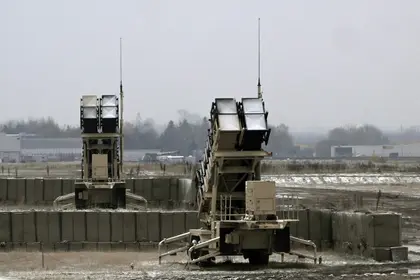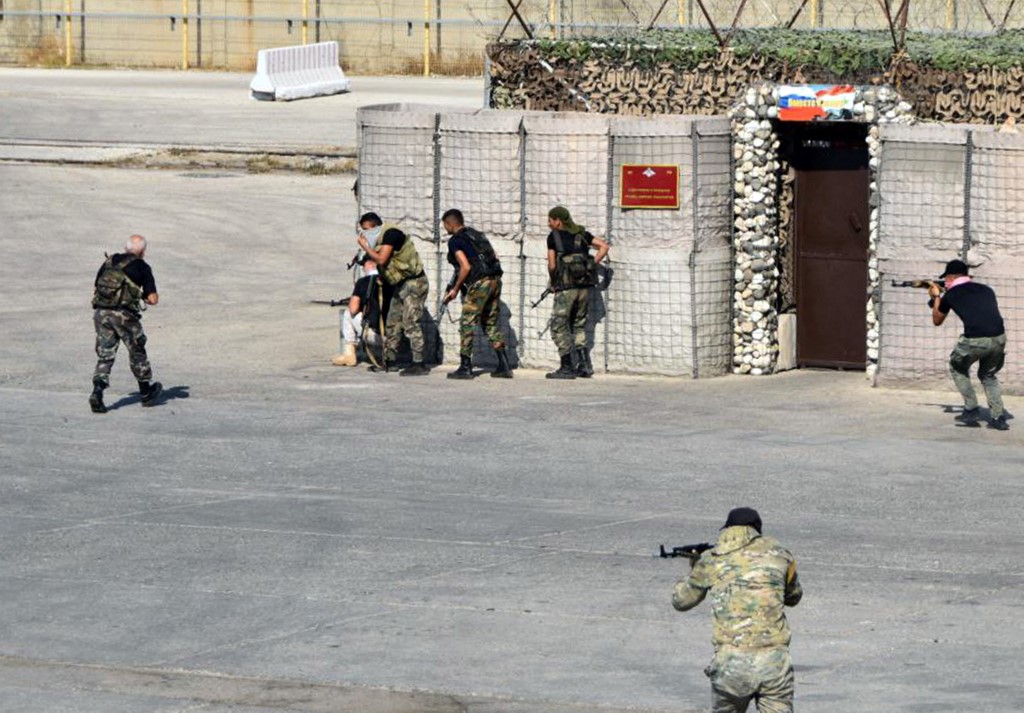Ukrainian attack drones flew hundreds of kilometers deep into Russia to hit a heavy bomber base during the early hours of Tuesday morning, with residents and local news platforms reporting explosions and flames at the airfield.
Russia’s Defense Ministry in a morning statement confirmed the attack and said local air defenses shot down nine Ukrainian drones attempting to strike Engels-1 military airfield, in the southeastern outskirts of the Volga River port city of Saratov. There were neither casualties nor damage, the official Kremlin announcement said.
JOIN US ON TELEGRAM
Follow our coverage of the war on the @Kyivpost_official.
Social media video geo-located to the center of the city of Saratov, 750 kilometers (466 miles) from the nearest probable Ukrainian drone launch sites, showed images of explosions and flames reaching into the sky from the vicinity of the airbase, anti-aircraft tracers flying skyward, and audio of cannons and heavy machine guns firing.


Kyiv Calls on NATO for 20 Advanced Air Defense Systems to Defend Power Grid
Some Ukrainian milbloggers suggested the Tuesday attack was aimed at munitions recently delivered to the airfield for later launch at Ukraine. The usually reliable Kyiv-based military observer Vertikal on Monday evening, citing Ukrainian government sources, said unspecified observers monitoring the airbase had spotted signs of missiles being unloaded at Engels-2 one day before the drone strike.
The Ukraine volunteer-operated Ukraine Front Line in a Tuesday morning X report said it was a batch of newly produced Kh-101/55SM cruise missiles delivered by an Il-76MD Russian Air Force cargo jet, and said fires observed at the airfield on Tuesday were of recently arrived cruise missiles, or aircraft, hit by one or more Ukrainian drones.
European Union Sentinel 2 satellite imagery made public on Sept. 14 and 15 and reviewed by the open-source military aviation researcher @MT_Anderson showed two Tu-22 supersonic bombers, one Tu-160 supersonic bomber, five Tu-95 turboprop bombers, and possibly a single AN-12 transport plane on the tarmac at Engels-2 airbase. The next Sentinel 2 overpass of Engels will take place on Sept. 18, he said.
Open-source Sept. 5 satellite images showed 5 Tu-95MS turboprop bombers and five Tu-22M3 supersonic bombers parked at Engels-2. None of those aircraft was visibly armed with missiles at that time, Ukrainian military information platforms said, though the weapons may have been loaded inside aircraft internal weapons bays.
Kyiv Post review of NASA satellite imagery showed no large heat signatures typical of fires following air strikes, at Engels-2 airfield captured on Sept. 17. However, the NASA fire detection satellites on Sept. 15 recorded heat signatures typical of ground fires in the vicinity of two possible air defense sites at Engels-2 airfield, and an even bigger heat signature centered on the base’s bomb and missile munitions storage areas.
Kyiv Post checks of civilian and official sources in Russia and Ukraine found no reference to attacks at the airfield on Sept. 15 and could not account for the probable fires spotted there by the NASA satellites.
A major airbase and a key piece of the Kremlin's long-range power projection capacity, Engels-2 is home to the 121st Guards Sevastopol and 184th Bomber Aviation Regiments, flying respectively Russia’s supersonic Tu-22M3 bomber (NATO: “Backfire”) and the turboprop Tu-95MS (NATO: “Bear”).
Pilots and ground personnel stationed at the airbase have carried out hundreds of strike missions against Ukraine since Russia’s full-scale invasion of Ukraine in February 2022, mostly by firing long-range cruise missiles from outside the range of Ukrainian air defenses.
Aside from missiles launched by long-range bombers, Russian strike planners hit targets deep inside Ukraine with surface-to-surface missiles, attack aircraft dropping glider bombs and Iran-manufactured kamikaze drones sent almost nightly.
Bombers from Engels-2 and other airfields on Aug. 27, along with strike aircraft and ground operators drawn from across west Russia, launched a record number of missiles in the war’s most massive air raid to date. Almost one hundred cruise and ballistic missiles, escorted by a similar number of kamikaze drones, targeted mostly Ukrainian power grid infrastructure. Six civilians were killed, and blackouts were reported across the country.

On Tuesday, the night of the drone attack against Engels-2, Ukrainian air defenses spotted no incoming bombers or missiles launched by them. During the night a total of 51 Russian explosives-tipped kamikaze drones flew into Ukrainian airspace, and air defenses shot 34 down, a Ukrainian Air Force statement said.
According to Kremlin statements, bomber-launched missiles target only Ukrainian military installations or energy infrastructure. Civilian homes and businesses are regularly hit, and most bomber raids kill or wound civilians. Kyiv officials led by President Volodymyr Zelensky have said Kremlin officials responsible for the bombardment campaign should be prosecuted as war criminals.
Ukrainian drone designers recently announced they had developed kamikaze drones capable of flying 1,800 kilometers. The top target for these weapons will be airfields where Russian long-range bombers attacking Ukraine, and the pilots that fly them are based, Ukrainian military intelligence chief Kyrylo Budanov said in an early September statement.
Before the Tuesday strike Ukrainian forces had, according to Ukrainian military information sources, successfully attacked Engels-2 only twice. The first strike, probably conducted by Ukrainian agents flying short-range FPV drones, took place on Dec. 26, 2022. The next attack came more than two years later, on Jan. 10, 2024, when a pair of Ukrainian drones reached the base and one hit the airfield, the Ukrainian military information web magazine Militarnyi reported.
Ukraine’s national leadership in recent months has pleaded with the White House for a green light to use the Ukrainian Armed Forces (AFU) made-in-the-US medium-range ATACMS missiles – a modern weapon designed to destroy airfields – to attack Russian airbases.
Policymakers in DC have said allowing Ukraine to do that is risky because Russia might retaliate. Engels-2 is well outside the range of the ATACMS missiles donated to Ukraine by the US.
You can also highlight the text and press Ctrl + Enter






